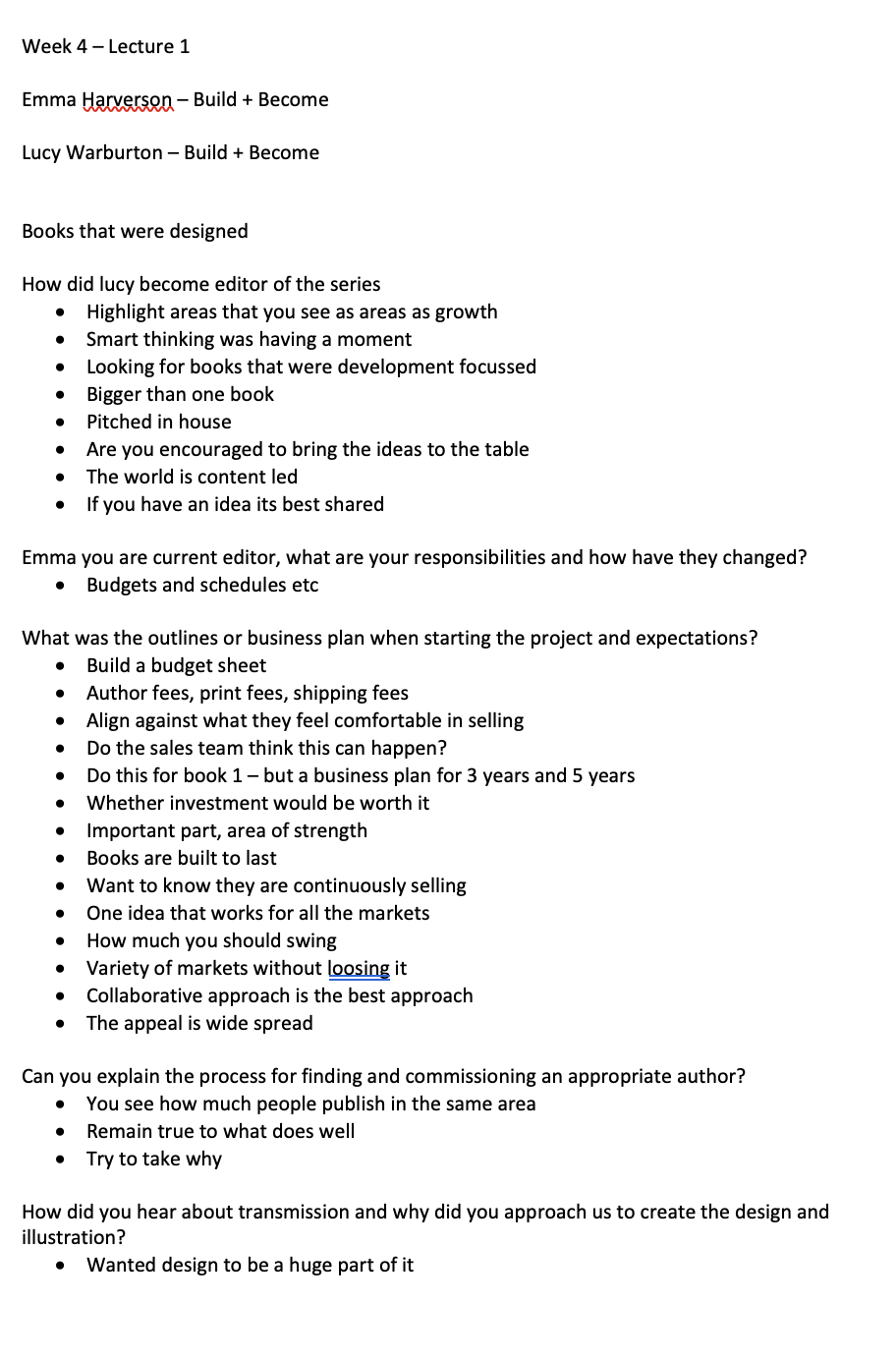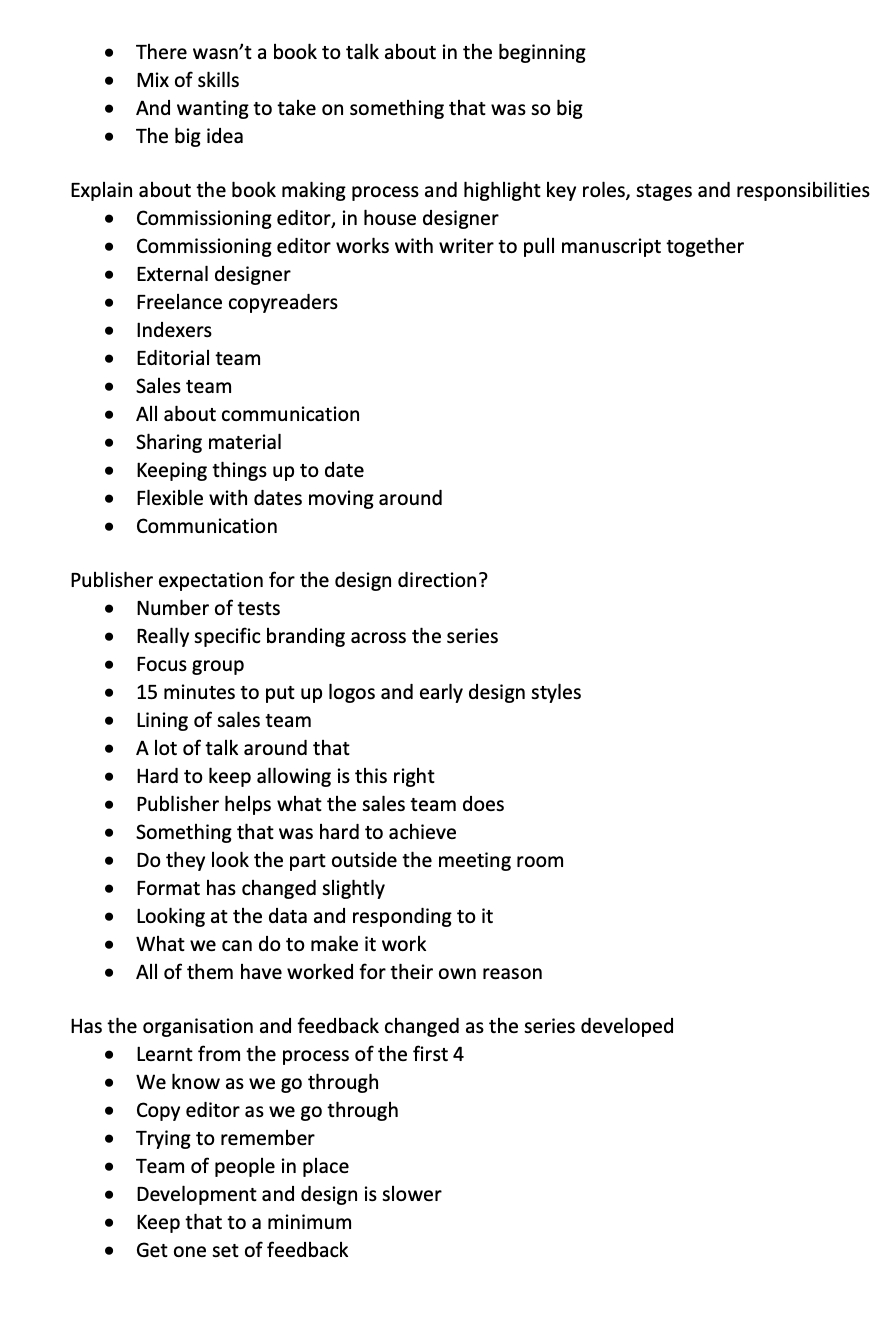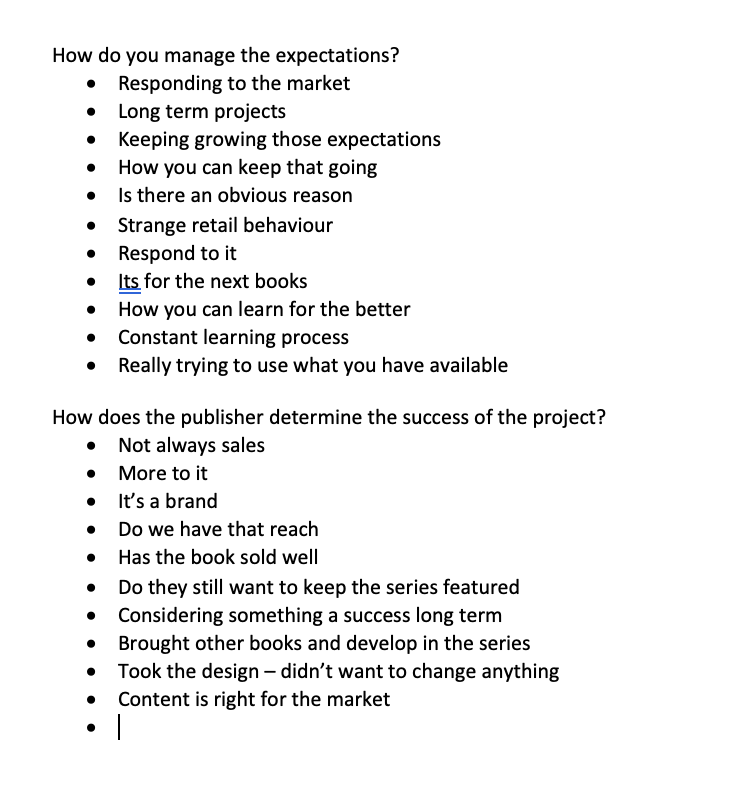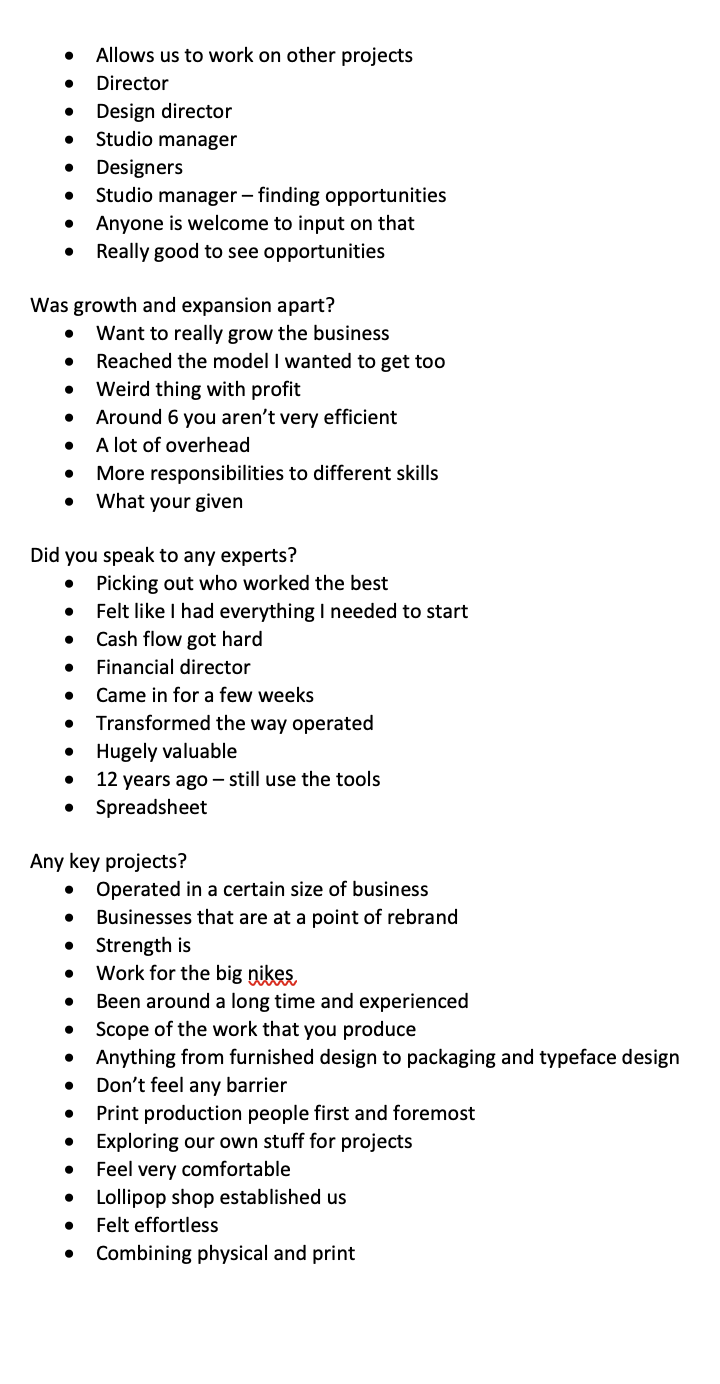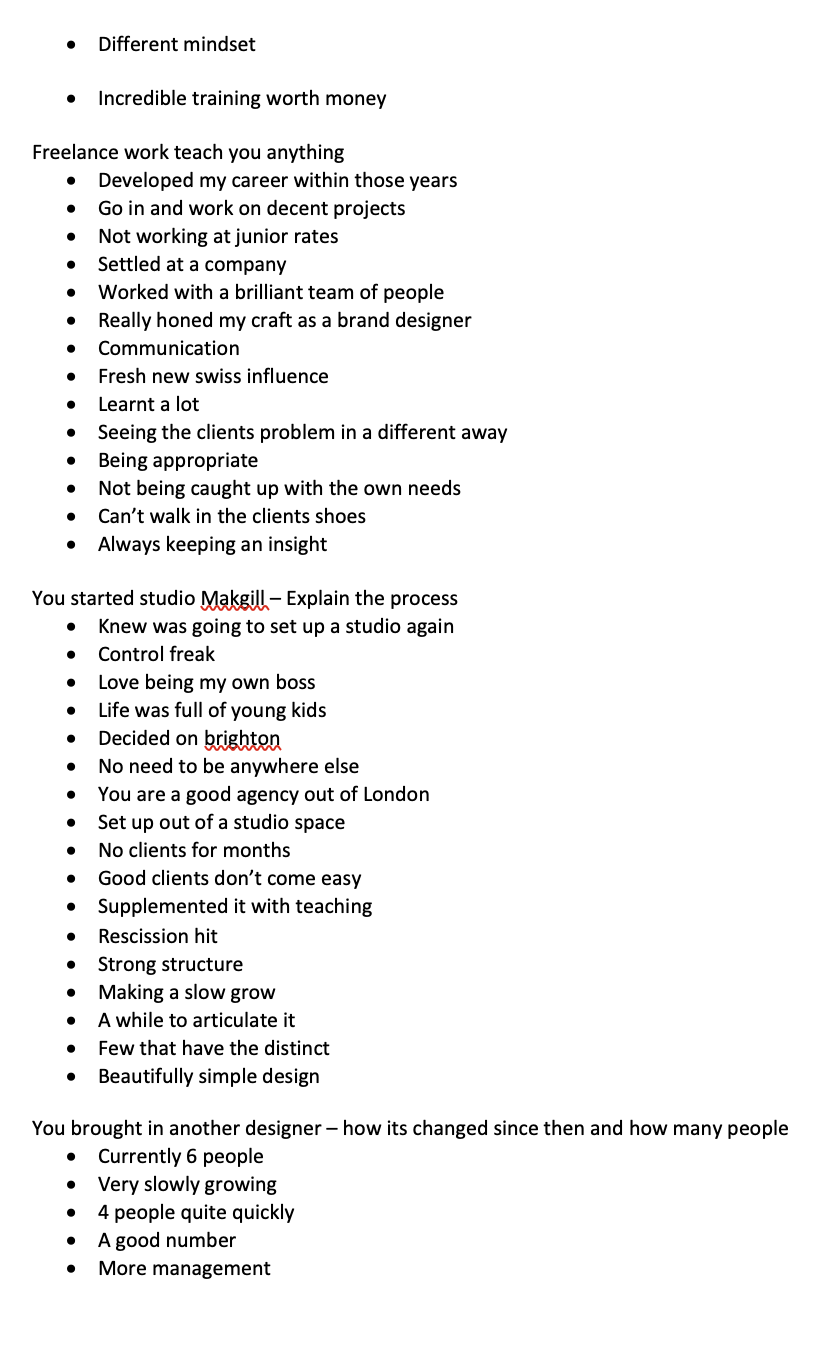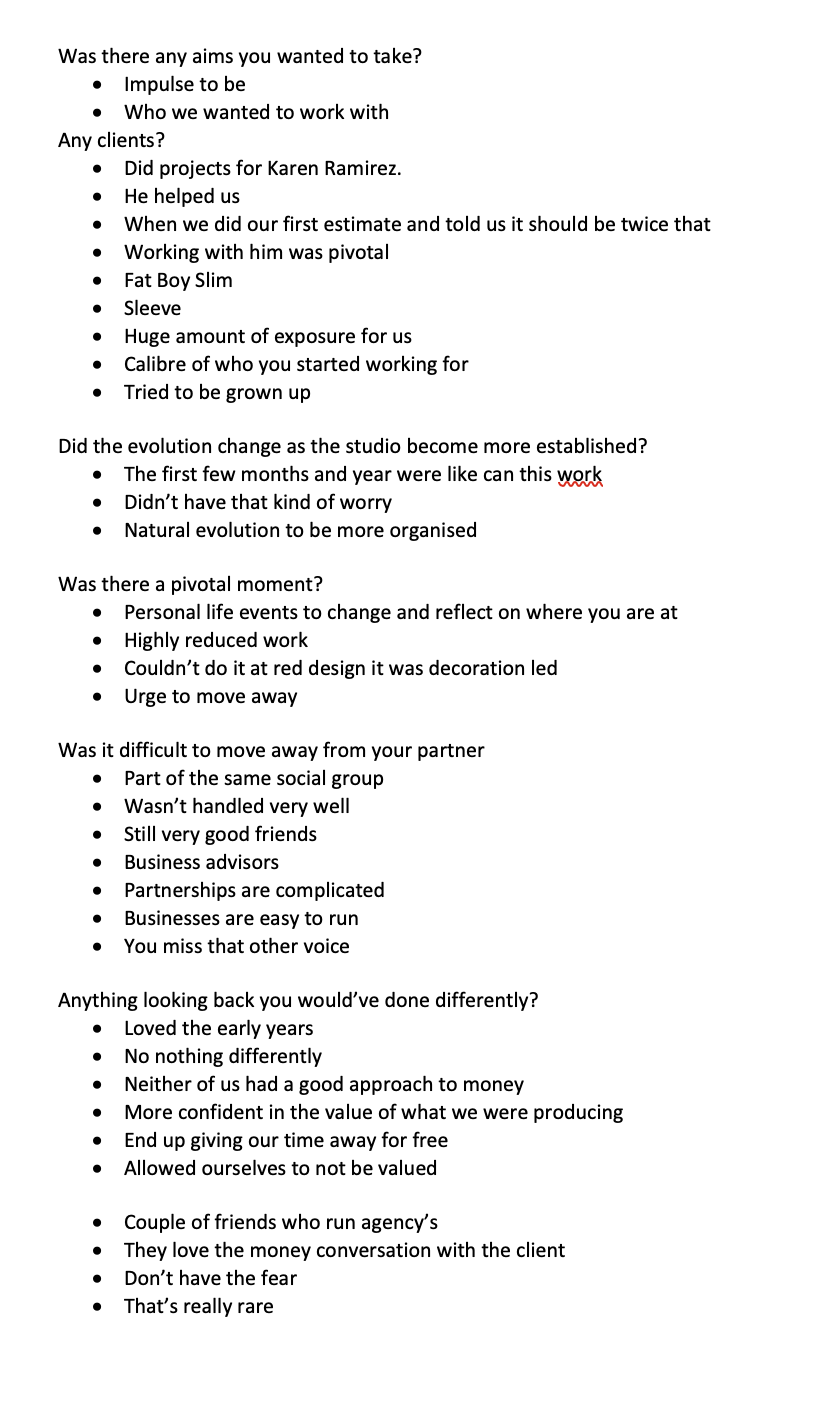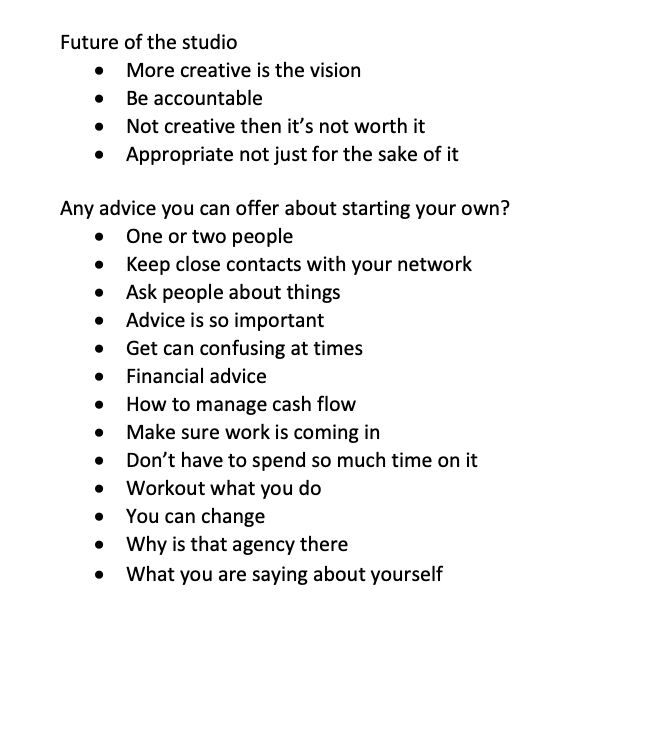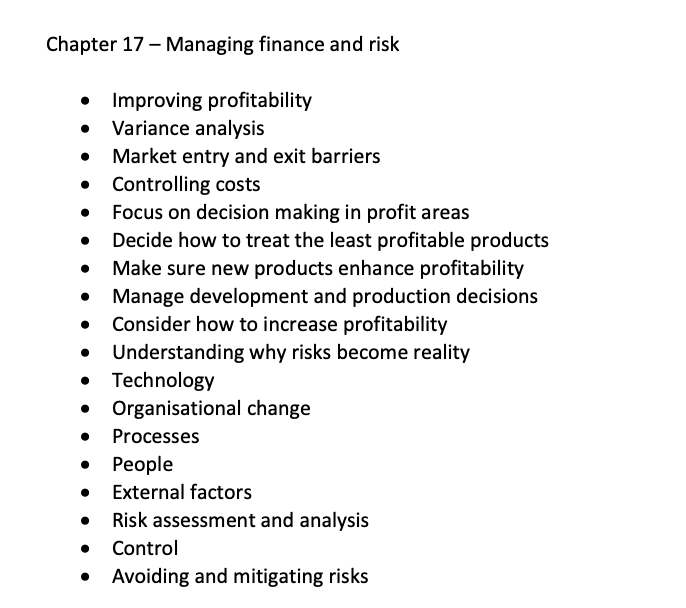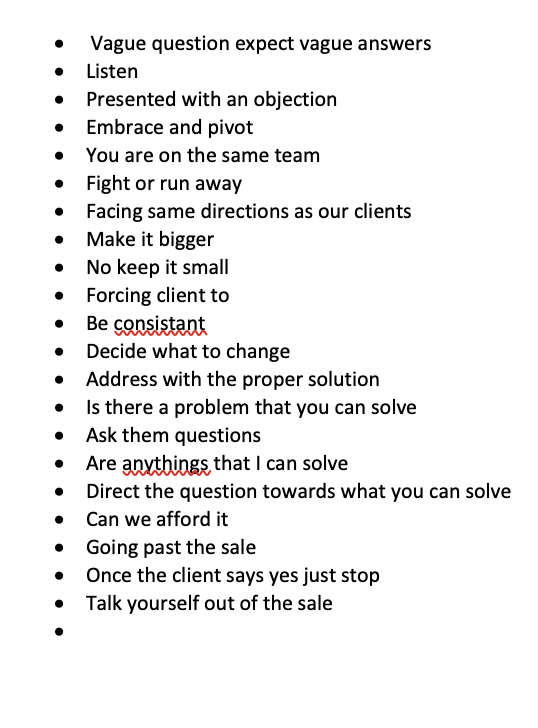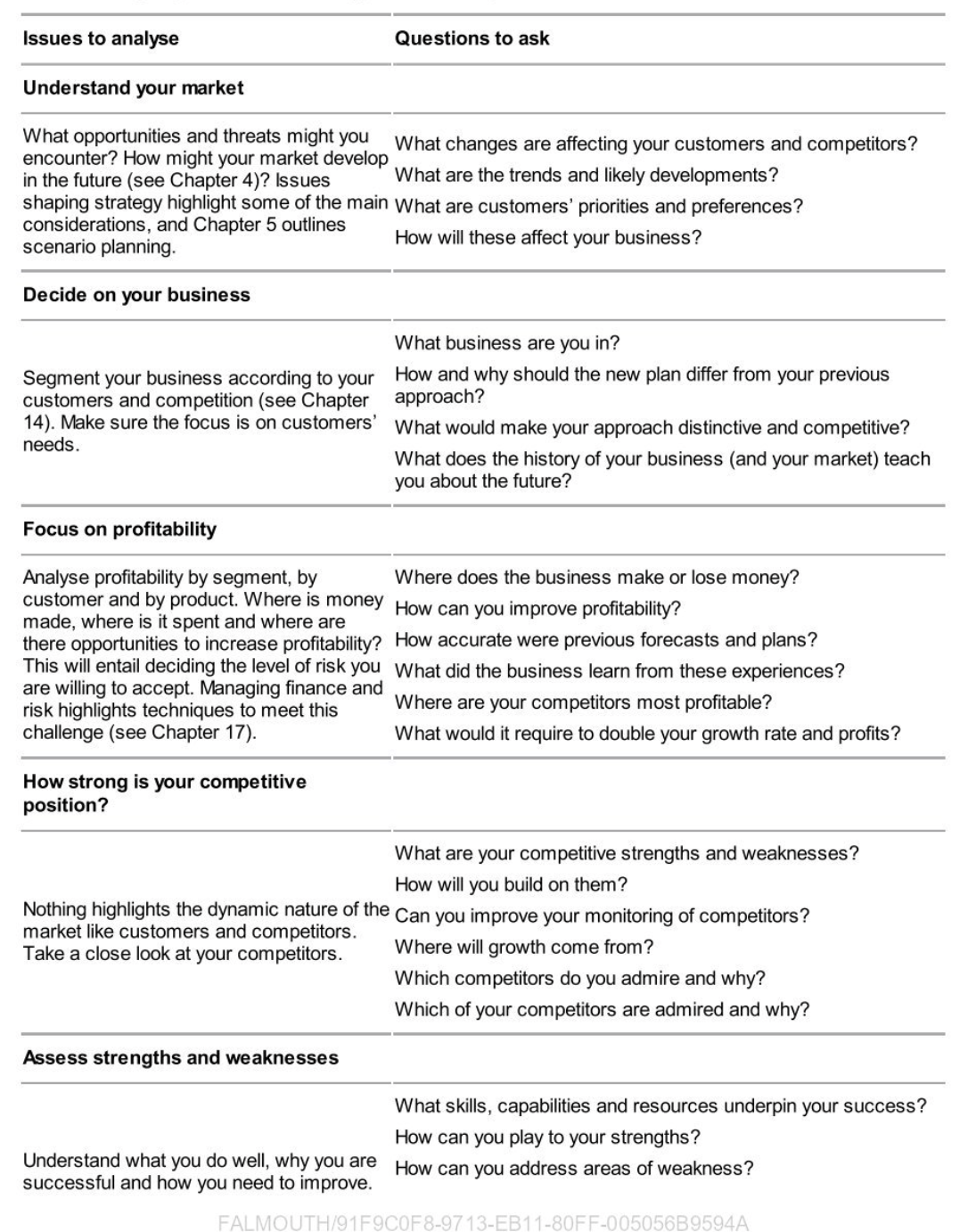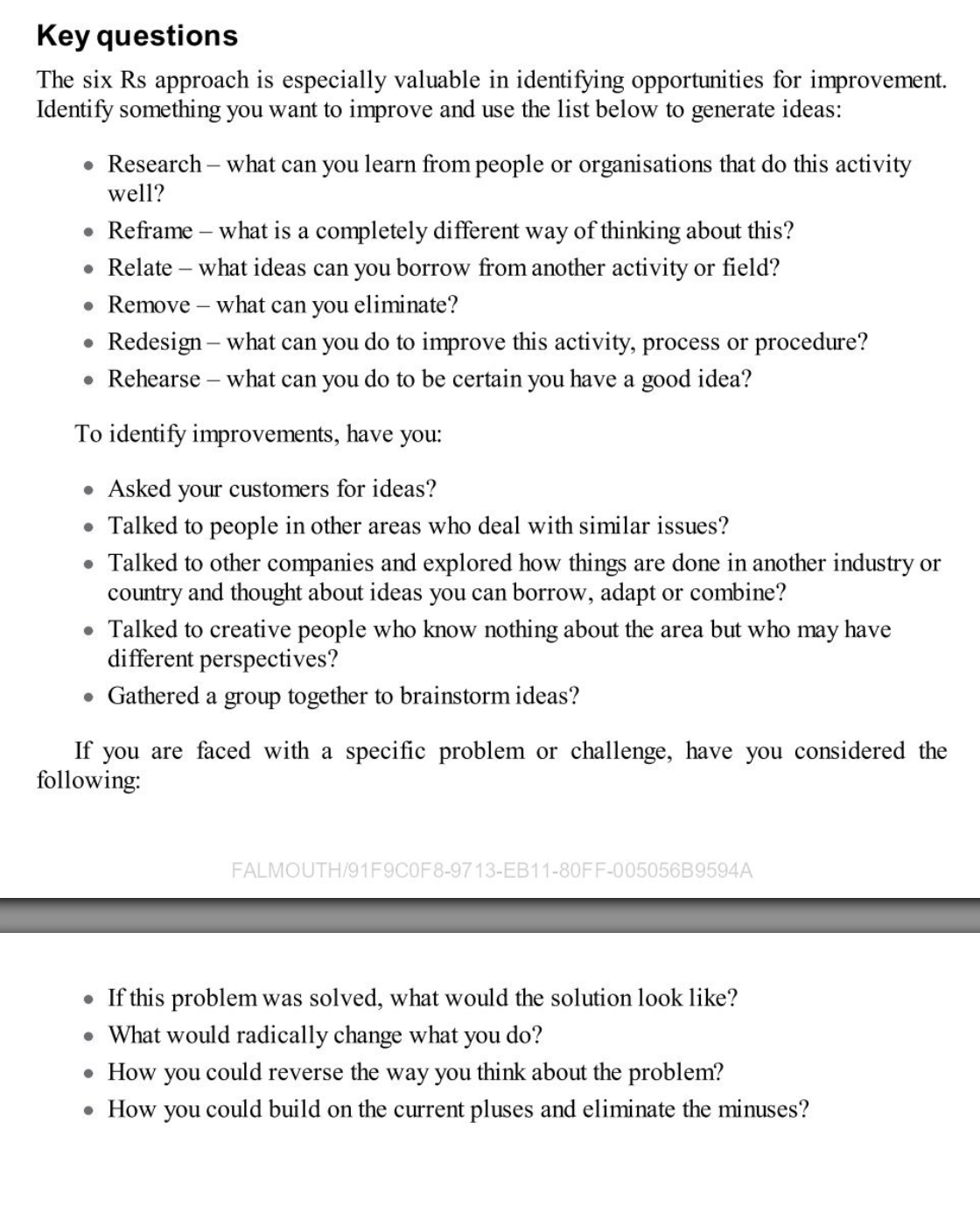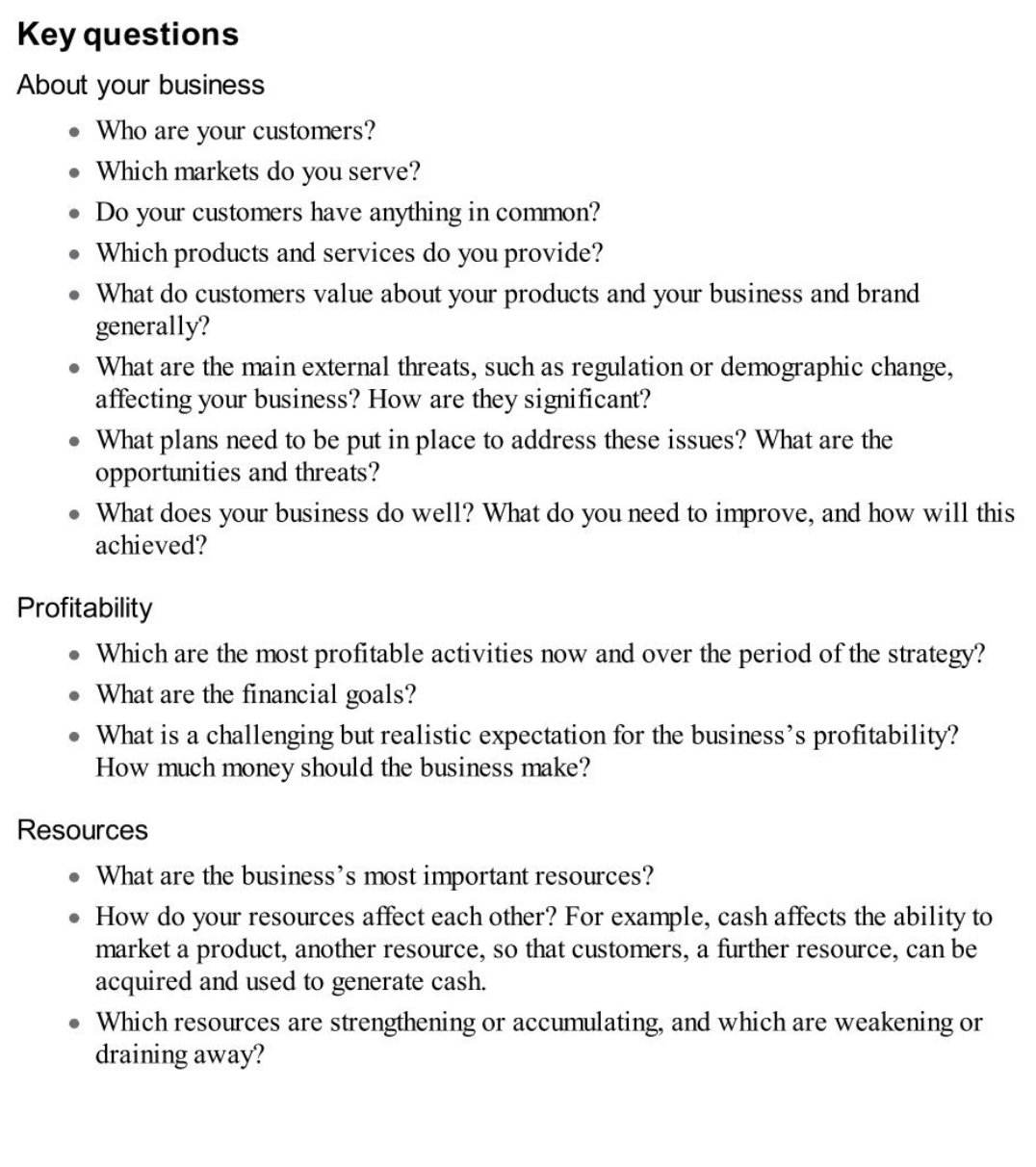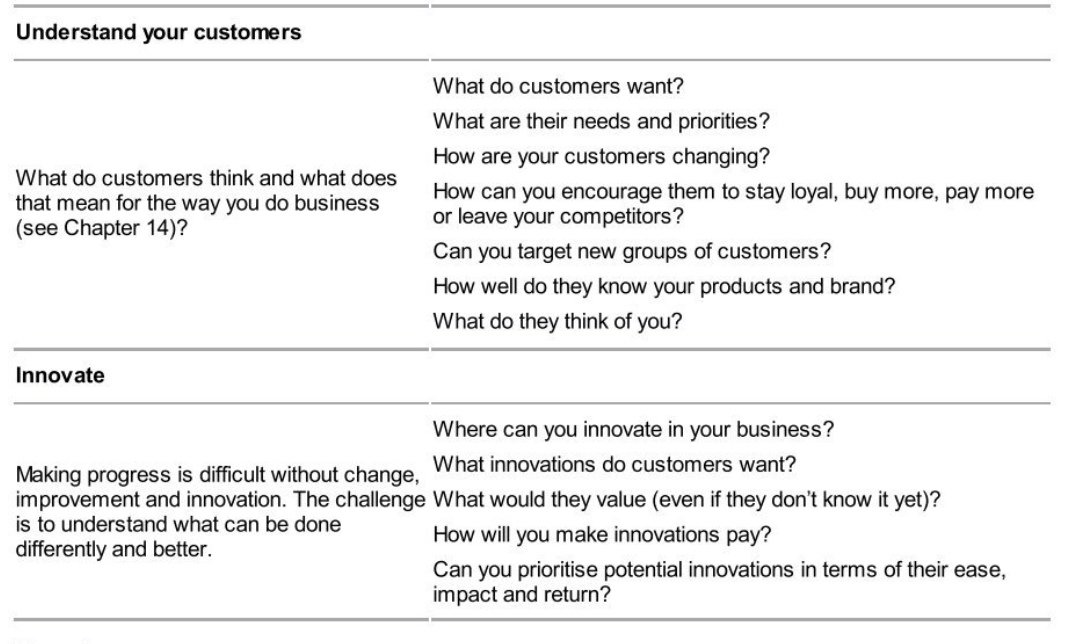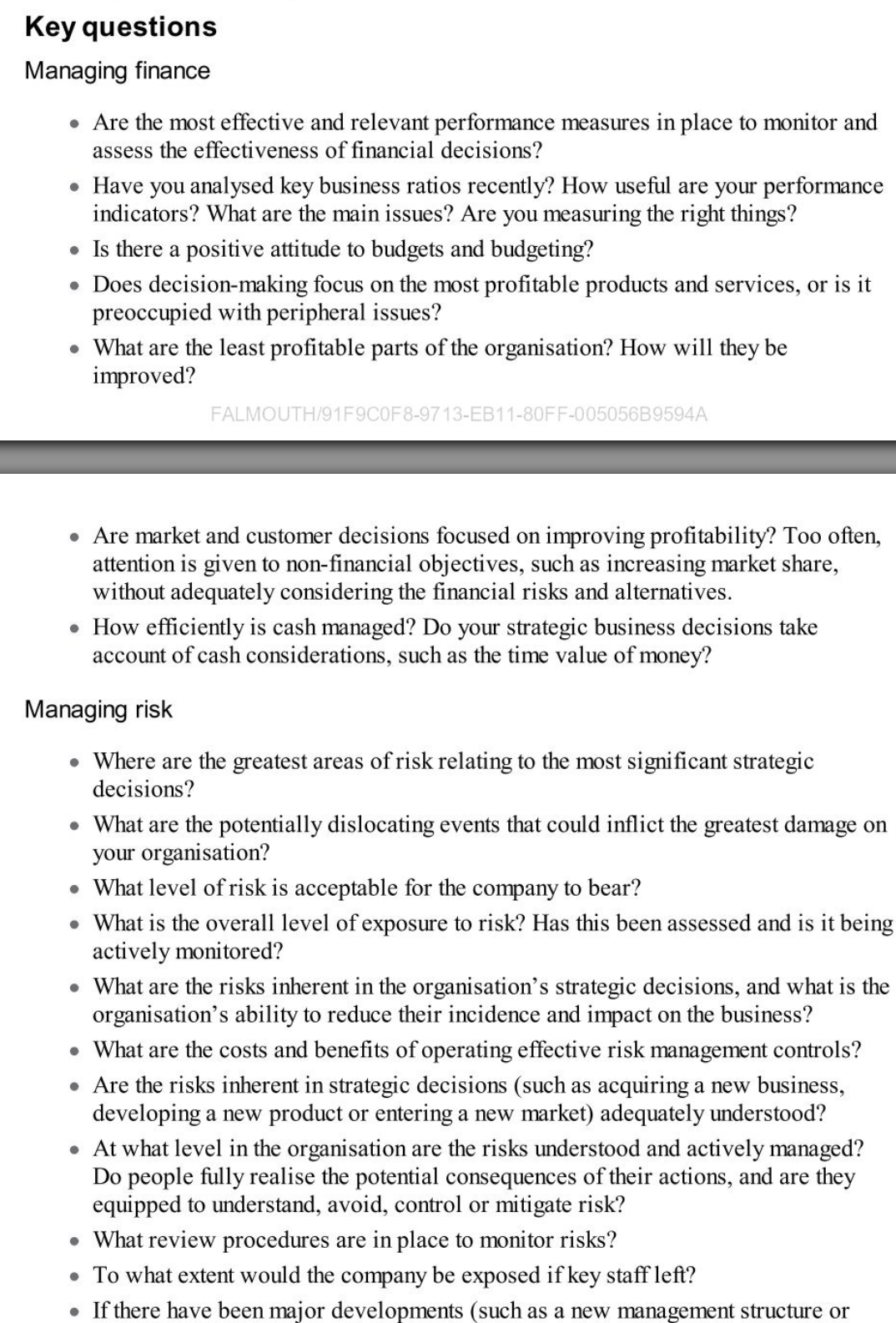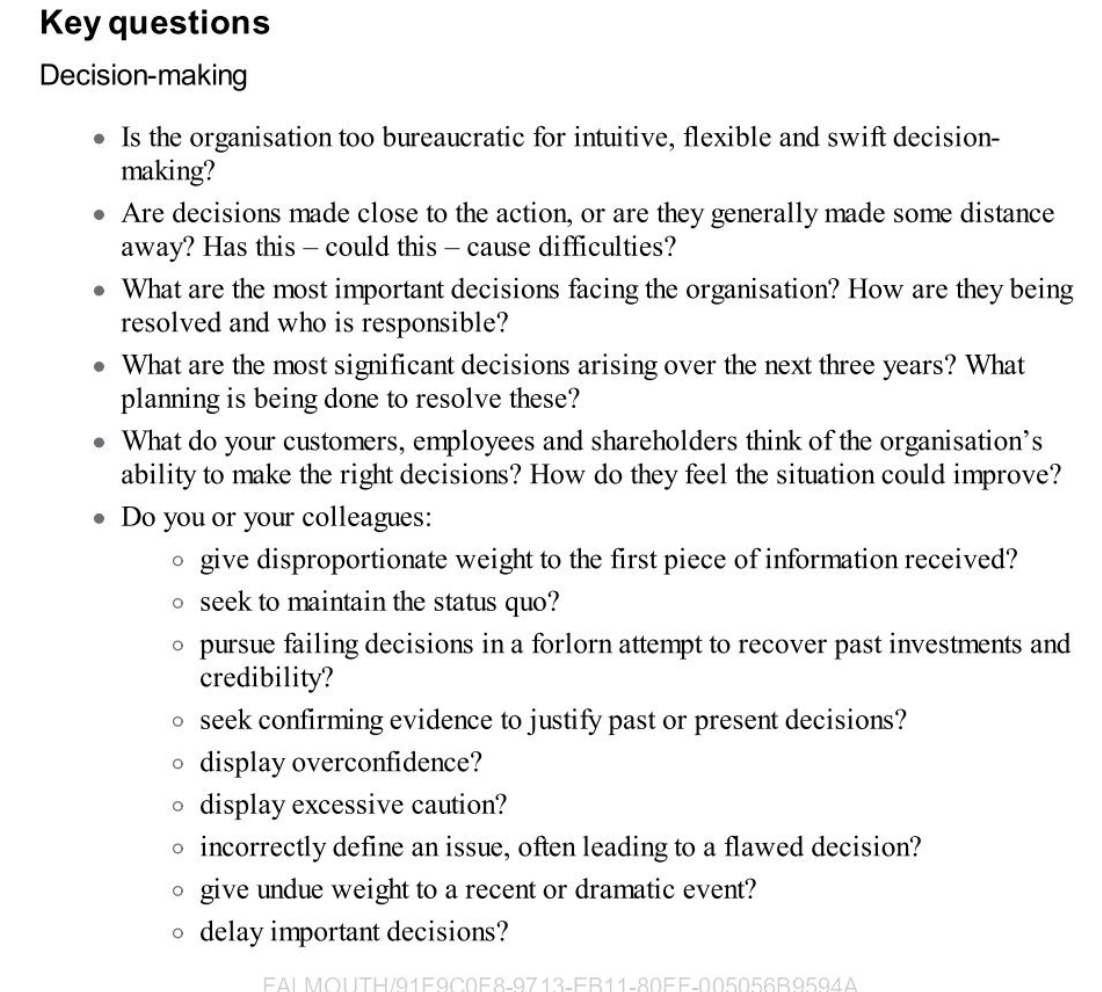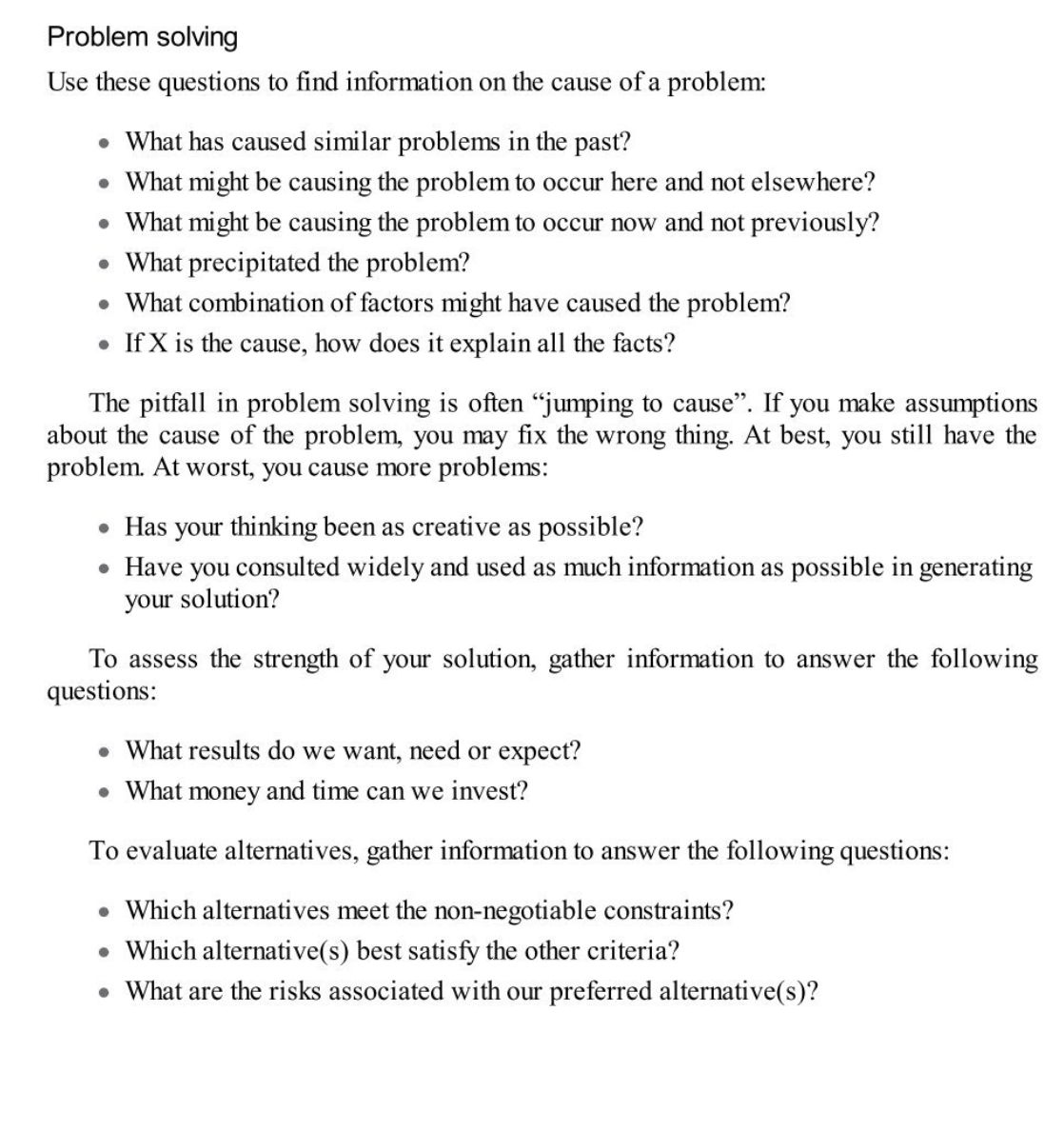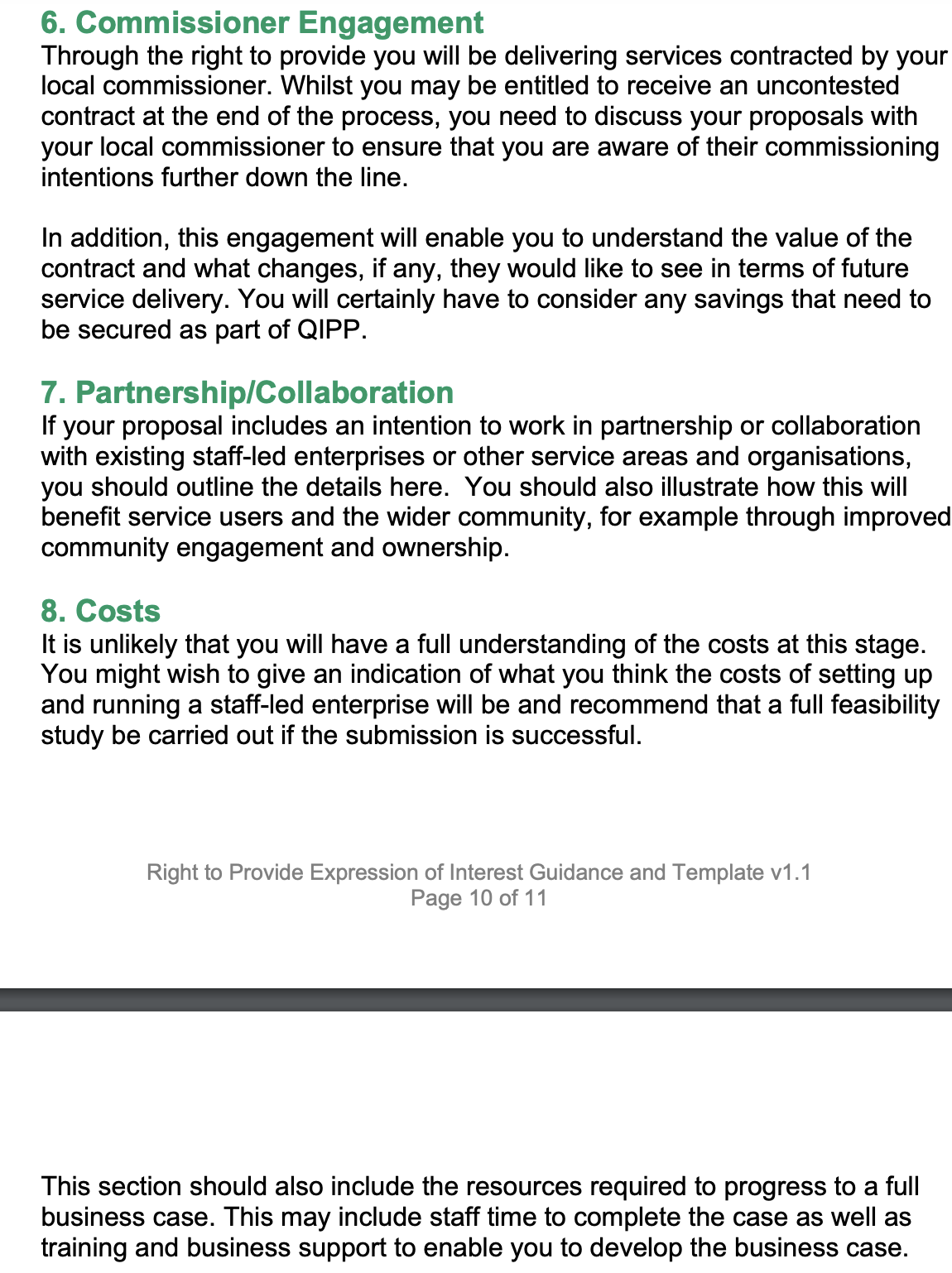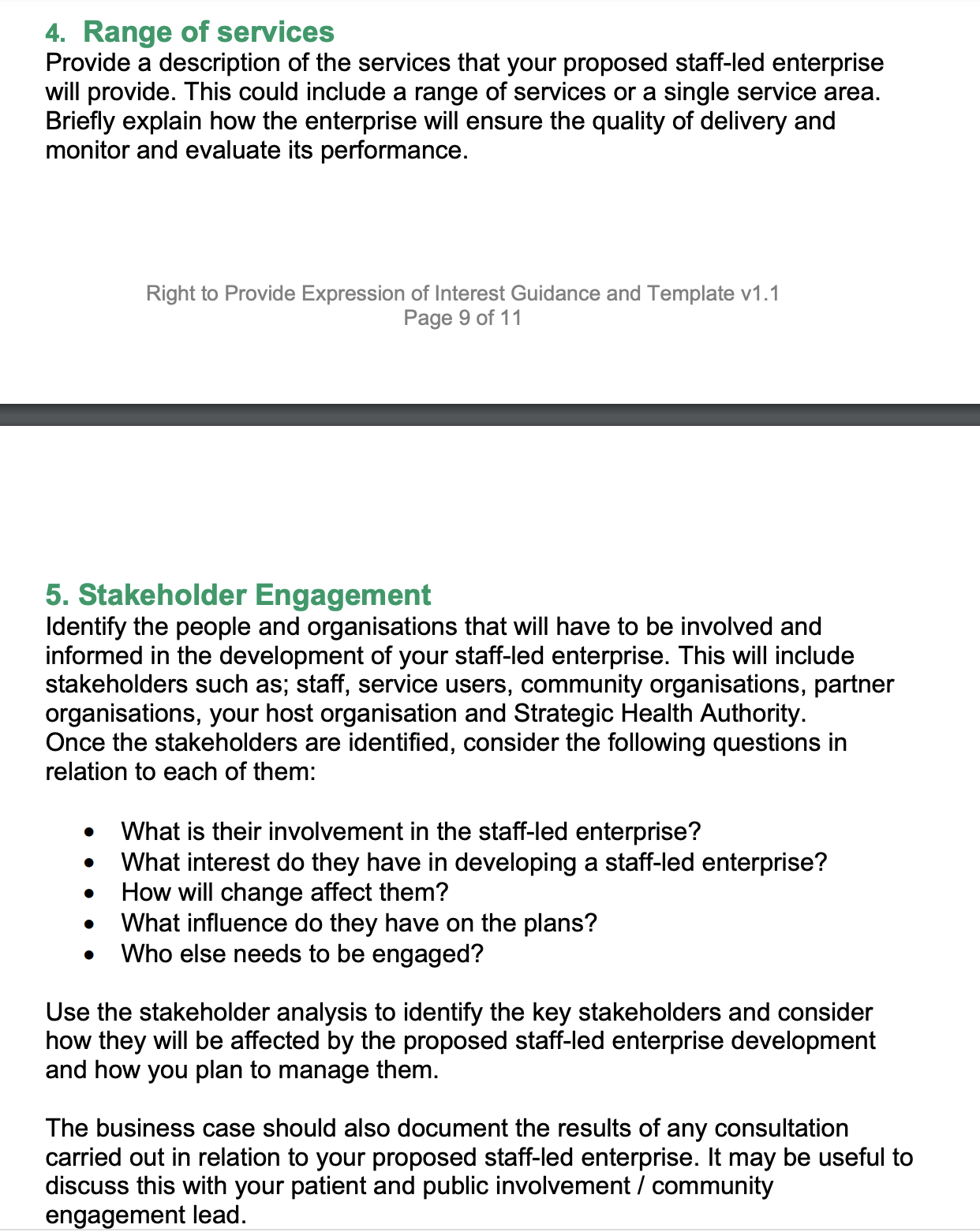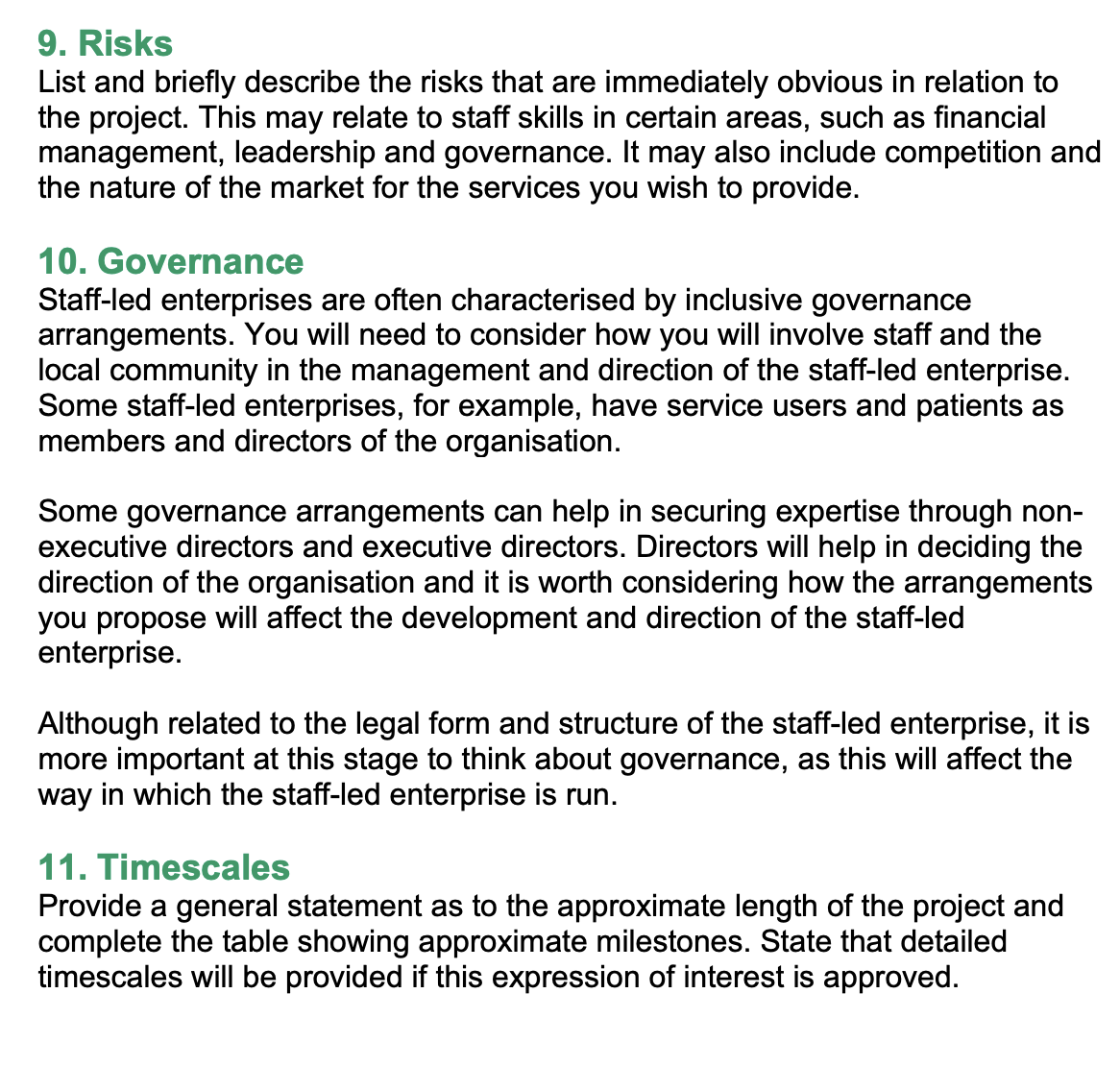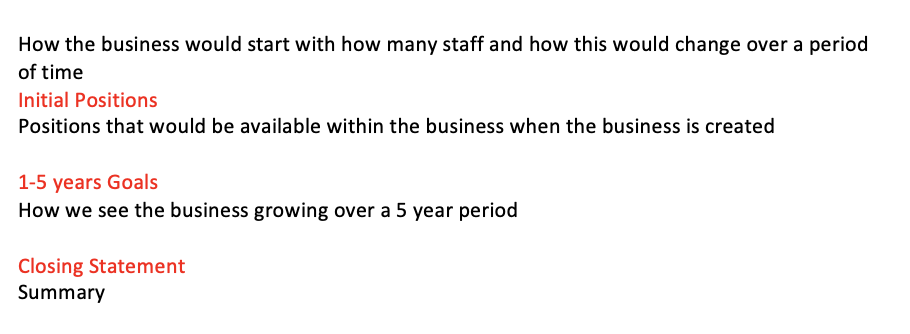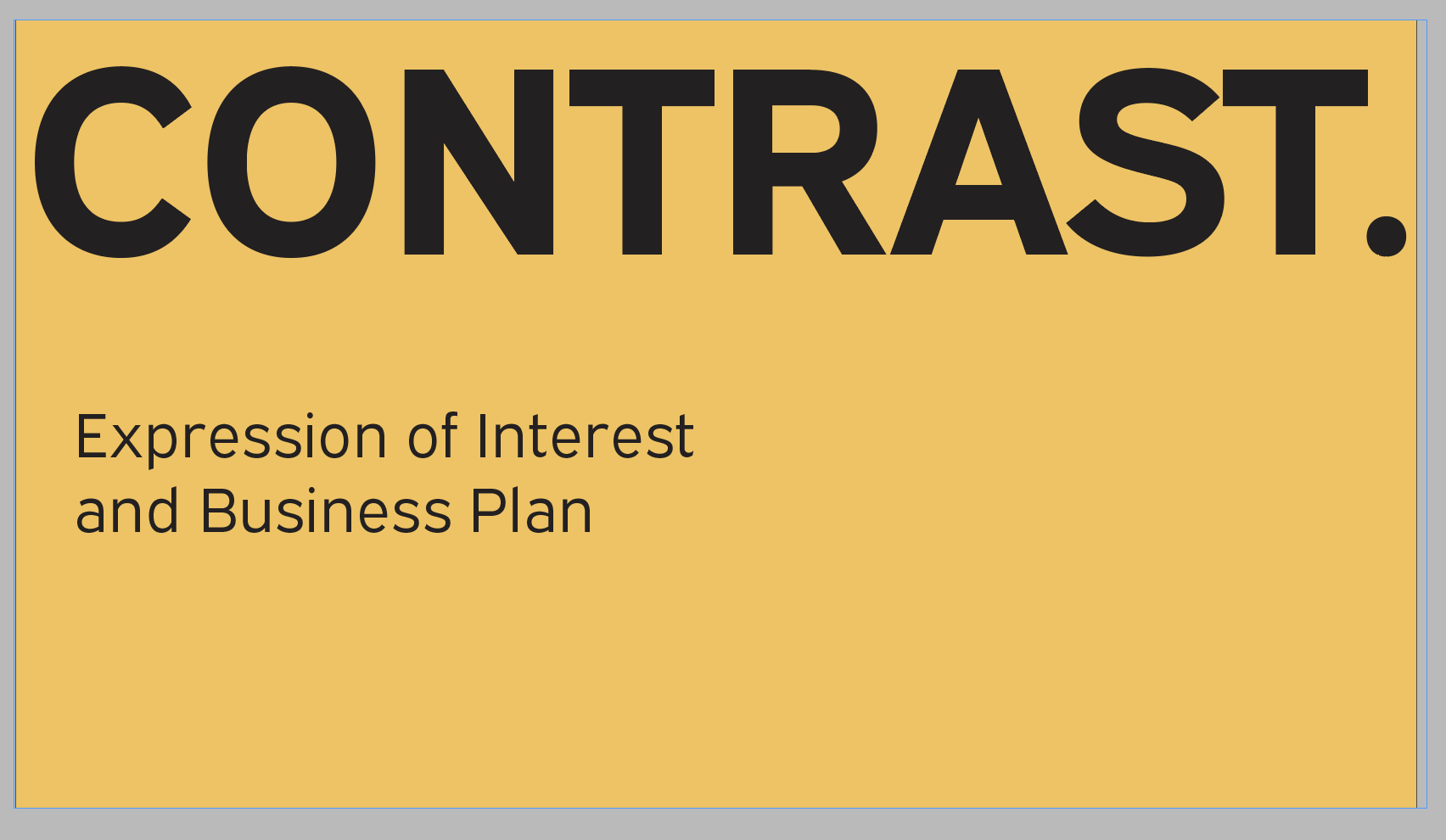Week Four
Lecture Notes:
Lecture 1
Lecture 2
Lecture Summary:
Within Lecture 1, talking about the overall process of the book but also how the book is created through the collaboration of the studio was really useful information. I thought that the book within the video background also looked cleanly created. Talking about how the book was created in house makes me think that they have taken everything thats kind of gone well from previous projects to apply to this project.
Within Lecture 2, Talking to Hamish Makgill. I thought this lecture gave a great overview to the process of starting your own business from being a graduate leaving university to then being a senior freelancer and all the ups and downs and things that he has learnt along the way. It was also interesting to note that he took what he learnt from working from someone else to set up Studio Makgill and he has the same layout as them. Who he’s employed and why he’s employed them and how he has expanded over 14 years.
Resource Notes:
Resource Summary:
Key Take aways:
Resource one:
One of the main take aways from Resource one was the below with the key questions to ask about certain things. I thought this was super helpful as sort of like the cards in a previous module, where you ask yourself questions about how to can change and then follow up questions to analyse and understand the business.
Resource 2:
Chris Do talks about how to be friendly with the client instead of the client being your enemy. I thought some of the points that he made within the resource was really interesting that i wanted to note them here:
Understanding what its like to be a client
Be consistant
Ask questions
then directly solve them
Stop when the client says yes
Happy years
Find what works for you
Make the client happy
Research:
Research, discover and analyse client/practitioner relationships and the service they provide.
Within this video with Chris Do, he makes the point that you have to listen to the client says initially and take their points on board. You can’t go in to to the meeting without having spoken to the client in the first place. He talks about how creative people are addicted to the highs and not the lows. Do to others what you wish them to do for you. Think about the last time you spent a lot of money on a customer service, and how it went and how you can implement those techniques within your everyday. Reverse engineering good customer service. Trust and earned over time. This enabled me to realise what was needed when talking to the client but also how i can take these techniques when designing a client facing document.
I also saw this related video with Spencer Fayre, who asks how you position yourself if you have no experience. Again I think this related to starting a company which I would be doing. Often we can seem too young to be credible. Chris makes a good answer in response to the question, saying that you are a good designer so you can charge, but also no matter what you are charging i think thats a discount and it should be higher. Learning and getting more experience would be the main point when thinking about how much to charge as yourself. Solve more problems than graphic problems. I think this video would have been super useful last week or 2 weeks ago but I am glad that i watched this now going on to price the business as i would be a start up business. Expert of solving problems for a lot of money.
Within this video with Flux, he’t taken the advice from Seth Goden, there are 3 types of relationships.
The client really knows what they want - come to the relationship with what they want - execectute on my ideas.
Client - works together to get the solution.
Client - You are the expert i need your help. Creative person makes all descisons.
The client side is the complicated side - Mixmatch of relationships which can lead to disagreements and fallouts with the client which then leads back to the resource with Chris Do talking about how to be-friend your client. The ideal relationship is to collaboratively work with the client.
Eli Altman and Chris Do talk about how to get a first design client which i think is crucial within this week especially designing a business plan and the marketing model. Within the video, they offer meeting loads of people, putting the work out there, aswell as approaching businesses that you think you can help. The main aim is getting out there and trying things. Getting started and who that first client is. If you are working within a studio, building client relationships that whole time. From graduating it’s from hyper thetical to real. This is also about doing this for the rest of your life and you need to be doing the work that you want to do.
From all that I have learnt above, I found a blog which outline the Client to designer relationship. It made some good points that related to the Maslow Hiarchy of needs when thinking about the client, this is a really different approach to working with a client. https://webflow.com/blog/client-designer-relationship
Through the stages of the Hierarchy, it talks about the Physiological needs taking care of the basics of yourself so you are able to reach the potential as a designer. The safety needs, having a good client relationship will mean that you communicate what you need to feel safe.
Love and belonging - getting on with your client professionally, connecting. With Esteem, you and your client should both push each other up instead of bringing each other down.
And finally self- actualisation - all or nothing with the client - communicating well and being supportive to enable you to create a good design for the clients needs.
This enabled me to see the needs of a client / designer relationship from another angle. Ultimately, having patience and communication seem to be the best tips for having a good designer / client relationship.
2. Research, analyse and define the formats and structure of a business plan.
There seems to be different ways of approaching the structure of a business plan. I wanted to research some of the basic methods that i could then take take these forward into the workshop challenge.
https://www.smallbusinesspro.co.uk/start-business/business-plan-structure.html
“Suggested Structure for Business Plans
The following structure will be accepted by most UK banks (you can check with them first) but is at least the minimum required:
Title page and confidential clauses
Executive Summary (objectives, products and services, target markets, financial projections, investment required)
Products and Services (Products summary, pricing, margins, profit per unit)
External Analysis (economic indicators, market research and trends)
Internal Analysis
SWOT Analysis (strengths, weaknesses, opportunities, threats)
Marketing Plan
Sales Plan
HR Plan (including CVs and bios of key staff)
Profit and Loss Account forecasts
Cash Flow Forecasts
Balance Sheet Forecast
Appendices for more detail
Starting to Write Your Plan
It can be difficult to begin writing a business plan and it's probably best if you start with your financial projections. Even a simple spreadsheet can get you started if you write down your product categories and how many you believe you will sell each day. Then you can set a selling price together with the cost of each sale to provide you with a margin and profit per item sold.”
This next business plan seemed to be a really indepth one:
https://articles.bplans.com/a-standard-business-plan-outline/
“1.0 Executive Summary
1.1 Problem
A summary of the problem you are solving and an identifiable need in the market you are filling.
1.2 Solution
A description of the product or service you will provide to solve the problem.
1.3 Target Market
A defined customer base who will most likely purchase the product or service.
1.4 Competition
The current alternatives or substitutes in the market that you and your business will be competing against.
1.5 Financial Summary
Key highlights of your financial plan that covers costs, sales, and profitability.
1.6 Funding Requirements
A brief outline of the amount of money you will need to start your business. Include this if you plan on pitching to investors.
1.7 Milestones and Traction
A roadmap of where you currently are and specific milestones you plan to hit.
2.0 Opportunity
2.1 Problem Worth Solving
A thorough description of the problem or pain point you intend to solve for your customer base.
2.2 Our Solution
A thorough description of your proposed product or service that alleviates the problem of your customer base.
2.3 Validation of Problem and Solution
Any data or relative information that supports your solution. If you’ve already run tests that verify your idea, this is the place to include your results.
2.4 Roadmap/Future Plans
A list of steps taken so far, along with an outline of steps you plan to take in establishing or growing your business.
3.0 Market Analysis Summary
3.1 Market Segmentation
Potential groups of customers separated by specific characteristics.
3.2 Target market segment strategy
Your ideal customer who would most likely benefit from your business.
3.2.1 Market needs
A description of how your target market is not effectively served and how your business fulfills a need.
3.2.2 Market trends
How consumers in your target market tend to act including purchasing habits, financial trends, and any other relevant factors.
3.2.3 Market growth
The perceived potential increase or decrease in the size of your target market.
3.3 Key customers
Your ideal customer archetype who will be the main advocate for your business.
3.4 Future markets
A snapshot of the potential market based on the last few sections and how your business strategy works within it.
3.5 Competition
A list of potential competitors. Identifying the competition isn’t always obvious and it may take some digging on your part.
3.5.1 Competitors and alternatives
A list of potential indirect competitors that provide products or services that are alternatives to your business.
3.5.2 Competitive advantage
The strategic advantage(s) that makes your target market more likely to choose you over the competition.
4.0 Execution
4.1 Marketing plan
An outline of your marketing and advertising strategy including costs, advertising channels, and goals.
4.2 Sales plan
An estimate of the number of sales you anticipate based on market conditions, capacity, pricing strategy, and other factors.
4.3 Location and facilities
Details of your physical business location (if necessary) including location and costs of operation.
4.4 Technology
An explanation of any new technology that defines your business.
4.5 Equipment and tools
Any required production equipment or tools and the cost associated with purchasing or renting them.
4.6 Milestones
A detailed roadmap of specific goals and objectives you plan to achieve that will help you manage and steer your business.
4.7 Key metrics
Performance measurements that help you gauge the overall performance and health of your business.
5.0 Company and management summary
5.1 Organizational structure
An overview of the structure of your business including roles and responsibilities of specific employees and the flow of information between levels of the organization.
5.2 Management team
A list of potential candidates you anticipate taking on high-level management roles within your company.
5.3 Management team gaps
Any positions or areas of expertise that you currently do not have candidates ready to fill those roles.
5.4 Personnel plan
A list of potential positions that you expect to require in order to run your business effectively.
5.5 Company history and ownership
A summary of your company’s history and how it relates to planning your business.
6.0 Financial plan
6.1 Revenue and sales forecast
Expected revenue and sales for the next 1-3 years, broken down into month-by-month increments for at least the first year.
6.2 Expenses
6.3 Projected profit and loss
6.4 Projected cash flow
6.5 Projected balance sheet
6.7 Business ratios
Standard statistical indicators that showcase the current and projected health of your business.”
I feel this was a super indepth business plan, so i think ill probably take the key points from the above. On the same website they also had information and tips on writing one:
https://articles.bplans.com/how-to-write-a-business-plan/
Keep it short
know your audience
Test your idea
Establish Goals
Don’t be intimdated.
Comparing this to another business plan:
https://www.shopify.co.uk/blog/business-plan-template
“Executive summary. A one-page summary of your whole plan, typically written after the rest of the plan is completed.
Company description. An overview can include many potential sub-sections, from the basics (your type of business model) to the meaningful (your business’ vision and mission statement).
Market analysis. Everything from estimated market size to your target markets. It’ll also include a competitive analysis of your industry to address competitors strengths and weaknesses.
Products and services. What you sell and the most important features of your products or services. It’ll also include any plans for intellectual property, like patent filings or copyright. If you do market research for your products, it’ll show up in this section of your business plan.
Marketing plan. How you intend to get the word out about your business, and what strategic decisions you’ve made about things like your pricing strategy.
Logistics and operations plan. Everything that needs to happen to turn your raw materials into products and get them into the hands of your customers.
Financial plan. It’s important to include a look at your financial projections. This section includes templates for three key financial statements: an income statement, a balance sheet, and a cash-flow statement.”
I also quickly did look up an expression of interest and found this interesting layout on the goverment website:
Overall It seems to be very similar to a business plan in terms of content but possibly just a bit more focussed on what i need to be including in terms for the workshop challenge this week.
What are business plans used for really?
Before starting the research / challenge this week, I thought that business plans were only ever used to apply for loans at the bank but really they can be used for anything which is shown within the following article:
https://www.investopedia.com/terms/b/business-plan.asp
Within the article it talks about the different types of business plans and what business plans can be used for. It talks about how businesses can’t last long without a business plan as this plans the future and predictions of the company, keeping you on track. It also talks about how you should go into as much detail as possible within the business plan, i guess this enables you to be really clear about the forecasts for the company. There are also different variations of business plans, including short business plans which are normally just one page long.
Workshop Challenge:
How do you write a client facing strategic document for the purpose of a new business challenge?
Create a format and structure for a new business plan. You have considered company philosophy, leadership, budgeting, IP, and now we want you to create a 3,000-word business plan that presents your proposal to your client. This plan will be used to write a client facing project, or as an outline for a potential studio launch or entrepreneurial idea or artefact. This is very much a speculative exercise that will grow and evolve as you move through the rest of the course.
One of the key challenges of this exercise is for you to target your writing and proposal to a specific audience and therefore the research, your strategy, your communication skills and outline of management or organisational objectives, are central to this challenge.
Imagine, clearly communicate and deliver a 3,000-word business plan that presents your proposal to your client, partner or investor.
For this output I have decided to create a front facing part to the document, which is targeted towards potential clients and then the second part of the document will be more of an internal business plan with a lot of the in house aims.
I wanted to map out what i wanted to include within my business plan:
I found this page on what should be included within a business plan as the following:
https://smallbusiness.yahoo.com/advisor/resource-center/does-business-plan-140000974/
The Executive Summary. This is a concise one- to four-page summary illustrating the key points that are detailed in each section of the ensuing business plan. The Executive Summary should stand on its own as a separate document.
Business Overview. Offer a description of the business, including:
The legal structure
Business formation history
The type of business
Location
Means of doing business (Internet, storefront operation, mail order)
Operations Plan. Offer an explanation describing how the business will function, including the physical setup and responsibilities for specific tasks.
Market Analysis. Include an overview of the market as a whole, with specific data and charts or graphs, if appropriate. Define your target market and your plans for catering to this specific audience.
Products and Services. Describe the products manufactured or sold or the services offered. Classify the different types of products or services and provide a brief description of each.
Sales and Marketing. Outline pricing and sales information. Include rationalizations for why your audience will buy your products or services and how you will reach them through marketing and advertising efforts.
Competitive Analysis. Analyze the strengths and weaknesses of your direct and indirect competitors. Demonstrate how you will gain a competitive edge against your competition.
Management Team. Provide pertinent, concise background information on all key players involved in the business.
Financial Plan. Include all financial information, from startup costs to balance sheets. The financial section should outline:
The amount necessary to start or maintain the business
The amount needed over the next two, three, and even five years
Plans to use funds
Anticipated need for additional funding
Ongoing business expenses, including salaries, insurance costs, promotional expenses, etc.
Projections. Provide projected income statements and balance sheets for at least two or three years.
I also compared this to another website, which basically is very very similar.
https://www.growthink.com/products/business-plan-template
1. Executive Summary
2. Company Overview
3. Industry Analysis
4. Customer Analysis
5. Competitive Analysis
6. Marketing Plan
7. Operations Plan
8. Management Team
9. Financial Plan
10. Appendix
From this I created my own with the narrative of what to include within each section:
I’ve then decided to focus the first part on being client focussed and the second part on not being client fronted. The below would be client facing:
Table of contents - Foreword
Values Statement / Executive summary
Key outline of business
Vision Statement
What we want to do
Mission Statement
How we want to do it
Description of services
Main services that are on offer
Pricing / fee structure
Pricings calculated for each job
Process / Operations plan
The overall process of an average project
Client Case study - Portfolio
Outline of some of the work that’s already been done
The the other half wouldn’t be client facing:
Evaluation of your competition
Main competitors and how they compare to us
Market Trends
Within the area that the studio is, why is there a need for our studio?
Target Market
Who we aim to get business from
Marketing
How will we get new clients?
Marketing Strategy
How we see ourselves growing and getting new business
Studio – Location
Where the studio is based and what’s around
Financial plan for start up
Outlining the initial money that would be needed (overheads) As well as the goal with funding and monthly aims
3 different year financial goal
What the aim would be over 3 years of the start up and profit
Staffing Structure
How the business would start with how many staff and how this would change over a period of time
Initial Positions
Positions that would be available within the business when the business is created
1-5 years Goals
How we see the business growing over a 5 year period
Closing Statement
Summary
After reading one of the comments on the ideas wall, I have decided to change this to an expression of interest. Ben has mentioned that this would include the following:
“ this document would have info in like your studio manifesto / values, history, structure, employees / collaborators, service offered, how you manage projects, what your fees are, turnover and size. Then add to this - and include some things that perhaps you wouldn't include in a client facing EOI but that might be relevant to this challenge - eg competitive set, sector insights/ challenges / opportunities, legal structure and why you chose it, projections for the future in terms growth.”
What is an expression of interest:
“An Expression of Interest is an opportunity to present yourself in a clear, professional document. It is an opportunity to provide important information and to demonstrate your suitability, interest, availability in relation to the position.”https://www.monash.edu/__data/assets/pdf_file/0004/1531858/tips-on-writing-an-expression-of-interest-letter.pdf
Structure:
Changing my approach to this outline to include an expression of interest; I would section my business plan so that it has a front facing client document compared to a back of house business plan. Taking the information onboard from the articles above, the structure is the following:
Intro
Expression of Interest
Values
Vision
Mission
Services
Creative Fields
Studio
Process
Fees
Portfolio
Copy right
Closing Page
Business Plan
Market Analysis
Staffing
Finance
Once this was decided I began to answer the questions and statements that allowed me to start writing out the bulk of the business plan. Anything that I didn’t know, I just researched which was really helpful.
Tone of Voice
It was mentioned within my research this week to make sure that the voice you use throughout the document is clear. I decided to use the following for my document as we are a creative studio with multiple people:
Friendly
Professional
Together
Visual Process
Originally when I started my business plan, I had a black and white colour theme as well as pretty standard text which I thought would be interesting, which can be seen within weeks 1 & 2.
I did try other different layouts but none of them, I felt reflected who contrast was.
But with the name contrast, I felt that I needed to make a more bold statement with the design and the colour scheme. I introduced grey and yellow as well as black and white throughout the document which creates a strong contrast throughout. I also changed the font to something that was bolder as well as a standard header text.
Market Trends and Audience
I researched different market trends that would be around for this year and the ones that I thought would be important for Contrast to have implemented. Having always been a sustainable designer, I thought with the recent events of the past year it was important to be authentic as well as socially conscious tooo.
Socially conscious design
“To strive for a better future, it helps to visualize it.” (HubSpot, 2021)
After the past year and the social impact it has had on society, there is a new trend for creating designs for social need. Within the future there will be more designed posters or other forms of message that communicates unity and advice for the surrounding community. To address this we need to make sure that we are taking on projects with social aspect putting the community first.
HubSpot (2021). 13 Graphic Design Trends to Use in 2021 — and Two to Avoid. [online] blog.hubspot.com. Available at: https://blog.hubspot.com/marketing/graphic-design-trends.
Sustainable design
“ 81% of consumers strongly feeling companies should help improve the environment,” (Ellis, 2020) With majority of the world spending more time outdoors last year and seeing the impact that this has had on improving climate change, there is an increasing need for sustainable designs. This trend will only grow after the IPCC report that came out at the beginning of the year (May, 2020). To address this we need to make sure that we are minimising waste, reducing paper use as well as having an eco-mindset.
Ellis, M. (2020). 9 top digital marketing trends for 2021. [online] 99designs. Available at: https://99designs.co.uk/blog/marketing-advertising/digital-marketing-trends/#3
May, T. (2020). The biggest trends in graphic design for 2021, as predicted by leading creatives. [online] Creative Boom. Available at: https://www.creativeboom.com/resources/the-biggest-trends-in-graphic-design-for-2021/.
Authenticity
After the pandemic, there is an increasing need for more meaningful and authentic work that connects with the users on an emotional level. (May, 2020). To show clients that we are trust worthy, we need to make sure that we are completely transparent.
May, T. (2020). The biggest trends in graphic design for 2021, as predicted by leading creatives. [online] Creative Boom. Available at: https://www.creativeboom.com/resources/the-biggest-trends-in-graphic-design-for-2021/.
Marketing Strategy
I found a couple of interesting articles on Marketing Strategy that allowed me to fully understand the strategies that I would want to include within my plan:
Online Portfolio
Making sure that our website and online portfolio are regularly updated with our most up to date projects. We will make sure to not only include images of work but try to tell the stories of the commissioned projects. This strategy has the potential to engage future clients who are looking for active studios locally (Cass, 2020).
Cass, J. (2020). 10 Powerful Marketing Strategies for Designers. [online] Just Creative. Available at: https://justcreative.com/10-powerful-marketing-strategies-for-designers/
Social Media
Social media is an important way to engage with other businesses and future clients. Having a selection of our portfolio on our social media platforms will allow for engagement with fellow designers as well as future clients (Adams, 2017).
Adams, R.L. (2017). 10 Marketing Strategies to Fuel Your Business Growth. [online] Entrepreneur. Available at: https://www.entrepreneur.com/article/299335.
Build a Network
Attending events, talks and even taking part in competitions is a good way to build a network surround Contrast. Talking to people about the busines will allow for connections to be made and potential future clients (Cass, 2020).
Cass, J. (2020). 10 Powerful Marketing Strategies for Designers. [online] Just Creative. Available at: https://justcreative.com/10-powerful-marketing-strategies-for-designers/
Design associations
Making sure that we are a part of the correct design associations, this allows us to keep up to date within industry as well as meeting like-minded people and being able to be known online.
Word of mouth
As our reputation and business grows, we hope that word of mouth will be our main source of referrals.
Finance
The finance side of the document, I really utilised the previous documents that I had made in previous weeks that allowed me to have a thorough understanding of the finances needed. I made sure to check all the salaries against a proper website, I chose https://uk.talent.com/salary This allowed me to properly price up each year, as well as researching what things would cost when compared to the amount of people that I have within the offices.
My plan would be that I would initially start with a lower salary and then
Spreadsheets are listed below:
https://docs.google.com/spreadsheets/d/1iNh_iG9kYqVBDlV8nfERGBDXWaSp61wlDkxXU_2xtL4/edit?usp=sharing
https://docs.google.com/spreadsheets/d/1OFXyuCwpNY7gThu2lz48ddgqQ6UmW81qGH_NB3ofROo/edit#gid=0
Final Result
The final result of this week is of course the business plan document. I decided to split the document into 2 halves, having one side as an expression of interest and the other a business plan. The first section with the expression of interest would allow for a demonstration of the document that could be sent to clients for them to understand about the business. The second half would be kept within house which would allow for goals to be set and checked throughout the years.
The pdf outlines a marketing structure, staffing structure as well as financial goals that would help keep all of our goals in check.
The visual aspect of the document creates a contrast which goes to show how bold we are as a company and the changes that we want to make to the industry together. I feel the visual aspect reflects what is told within.
The pdf was too large to upload to the blog but the document side can be seen below.
To read this in normal format click here.
Weekly Summary:
This week started with really interesting lectures around business which allowed me to get in the mindset of understanding what would need to be researched later on in the week. I feel that that this week enabled me to understand what a business plan was and what needed to be included to get the message across the potential investors or even clients.
The output for this week was the business plan itself, which I struggled putting the information together that was needed. I tried really hard to research anything that I wasn’t able to do which helped me understand things as I went along. I am really proud of the outcome created and feel it is a clear concise document.
